Page 5 of 395
Your Car at a Glance
2
HOOD RELEASE
HANDLE
POWER WINDOW
SWITCHES
MIRROR CONTROLS
DOOR LOCK SWITCH
(P.79) AUDIO SYSTEM
DIGITAL CLOCK
(P.96)
(P.101)
HEATING/COOLING
CONTROLS
(P.112)
(P.206) HAZARD WARNING LIGHTS (P.72)
(P.134,150,169)
(P.139, 156,174)
TRUNK RELEASE HANDLE/
FUEL FILL DOOR RELEASE
(P.84/ 204)
Page 29 of 395
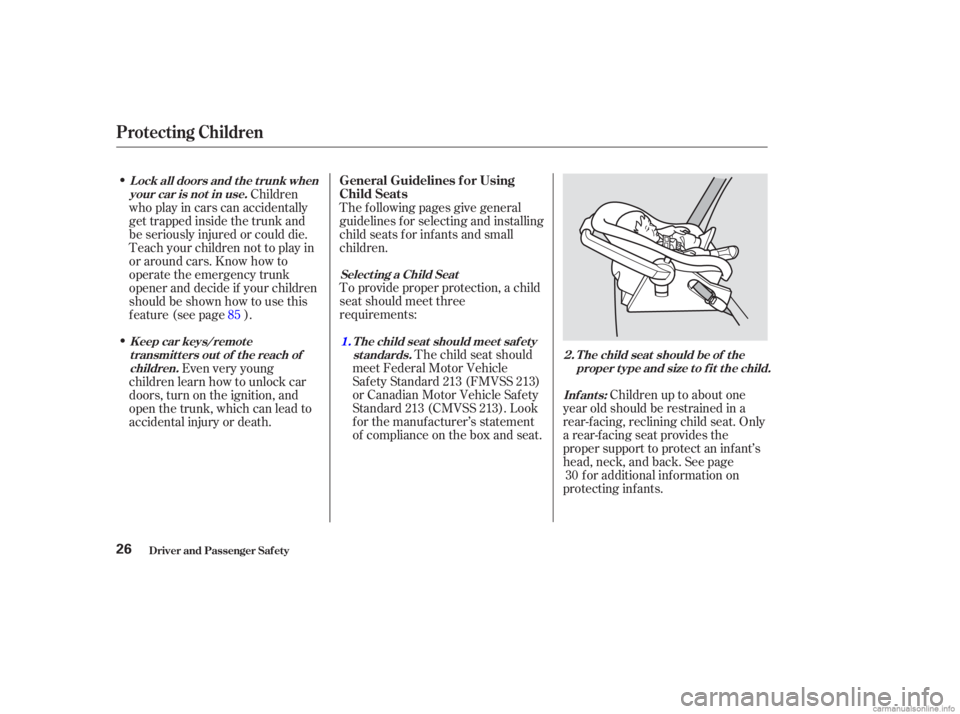
Childrenuptoaboutone
year old should be restrained in a
rear-f acing, reclining child seat. Only
a rear-f acing seat provides the
proper support to protect an inf ant’s
head, neck, and back. See page for additional information on
protecting inf ants.
The f ollowing pages give general
guidelines f or selecting and installing
child seats f or inf ants and small
children.
To provide proper protection, a child
seat should meet three
requirements:
The child seat should
meet Federal Motor Vehicle
Saf ety Standard 213 (FMVSS 213)
or Canadian Motor Vehicle Saf ety
Standard 213 (CMVSS 213). Look
for the manufacturer’s statement
of compliance on the box and seat.
Children
who play in cars can accidentally
get trapped inside the trunk and
be seriously injured or could die.
Teach your children not to play in
or around cars. Know how to
operate the emergency trunk
opener and decide if your children
should be shown how to use this
feature(seepage ).
Even very young
children learn how to unlock car
doors, turn on the ignition, and
openthetrunk,whichcanleadto
accidental injury or death.
30
85
T he child seat should be of the
proper t ype and size t o f it t he child.
Inf ant s:
Select ing a Child Seat
T he child seat should meet saf et yst andards.
L ock all doors and t he t runk when
your car is not in use.
K eep car keys/remot etransmitters out of the reach ofchildren. 2.
1.
General Guidelines f or Using
Child Seats
Protecting Children
Driver and Passenger Saf ety26
Page 55 of 395
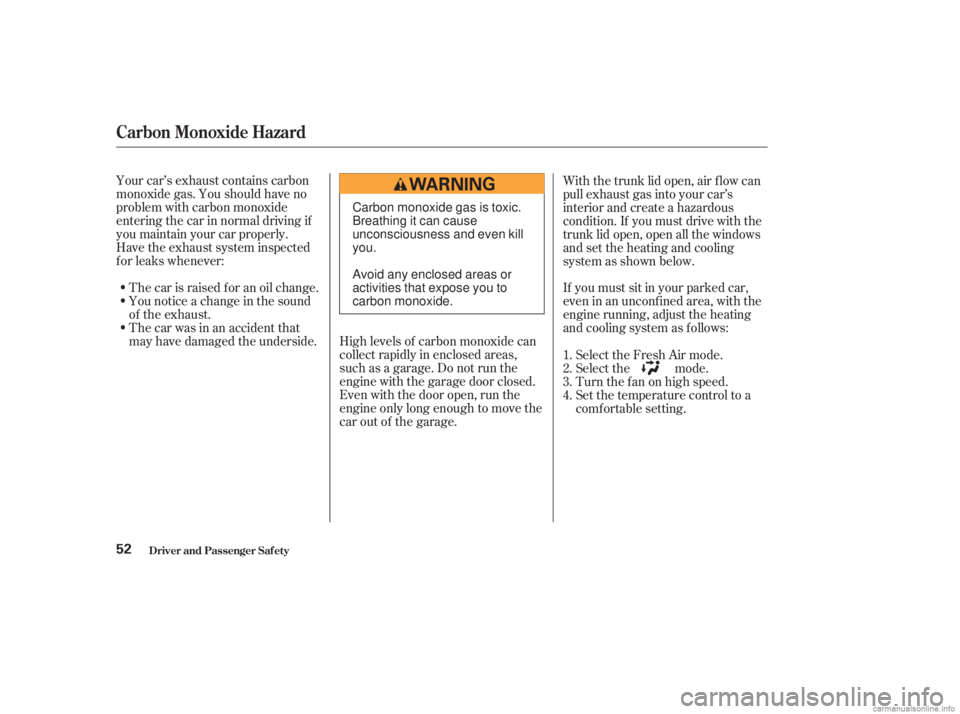
Your car’s exhaust contains carbon
monoxide gas. You should have no
problem with carbon monoxide
entering the car in normal driving if
you maintain your car properly.
Have the exhaust system inspected
f or leaks whenever:The car is raised f or an oil change.
You notice a change in the sound
of the exhaust.
Thecarwasinanaccidentthat
may have damaged the underside. If you must sit in your parked car,
even in an unconf ined area, with the
engine running, adjust the heating
and cooling system as f ollows: With the trunk lid open, air f low can
pull exhaust gas into your car’s
interior and create a hazardous
condition. If you must drive with the
trunk lid open, open all the windows
and set the heating and cooling
system as shown below.
High levels of carbon monoxide can
collect rapidly in enclosed areas,
such as a garage. Do not run the
engine with the garage door closed.
Even with the door open, run the
engine only long enough to move the
car out of the garage. Select the Fresh Air mode.
Select the mode.
Turn the f an on high speed.
Set the temperature control to a
comfortable setting.
1.
2.
3.
4.
Carbon Monoxide Hazard
Driver and Passenger Saf ety52
Carbon monoxide gas is toxic.
Breathing it can cause
unconsciousness and even kill
you.
Avoid any enclosed areas or
activities that expose you to
carbon monoxide.
Page 58 of 395
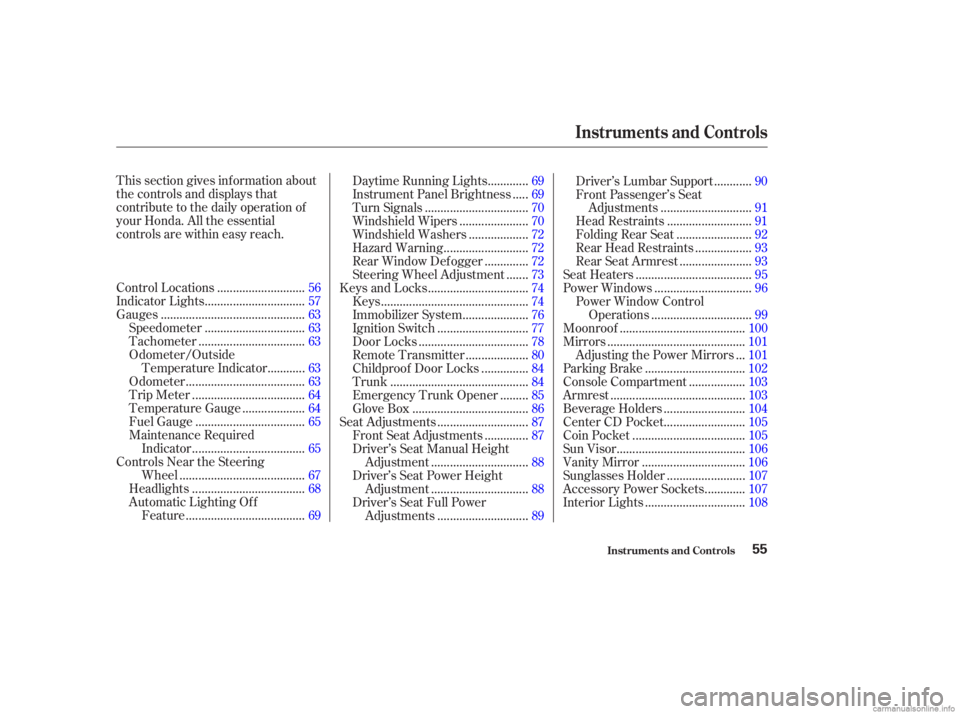
This section gives inf ormation about
the controls and displays that
contribute to the daily operation of
your Honda. All the essential
controls are within easy reach............................
Control Locations .56
...............................
Indicator Lights .57
.............................................
Gauges .63
...............................
Speedometer .63
.................................
Tachometer .63
Odometer/Outside ...........
Temperature Indicator . 63
.....................................
Odometer .63
...................................
Trip Meter .64
...................
Temperature Gauge . 64
..................................
Fuel Gauge .65
Maintenance Required ...................................
Indicator .65
Controls Near the Steering .......................................
Wheel .67
...................................
Headlights .68
Automatic Lighting Off .....................................
Feature .69 ............
Daytime Running Lights . 69
....
Instrument Panel Brightness . 69
................................
Turn Signals .70
.....................
Windshield Wipers .70
..................
Windshield Washers . 72
..........................
Hazard Warning .72
.............
Rear Window Def ogger . 72
......
Steering Wheel Adjustment . 73
...............................
Keys and Locks .74
..............................................
Keys .74
....................
Immobilizer System . 76
............................
Ignition Switch .77
..................................
Door Locks .78
...................
Remote Transmitter . 80
..............
Childproof Door Locks . 84
...........................................
Trunk .84
........
Emergency Trunk Opener . 85
....................................
Glove Box .86
............................
Seat Adjustments .87
.............
Front Seat Adjustments . 87
Driver’s Seat Manual Height ..............................
Adjustment .88
Driver’s Seat Power Height ..............................
Adjustment .88
Driver’s Seat Full Power ............................
Adjustments .89 ...........
Driver’s Lumbar Support . 90
Front Passenger’s Seat ............................
Adjustments .91
..........................
Head Restraints .91
.......................
Folding Rear Seat .92
.................
Rear Head Restraints . 93
......................
Rear Seat Armrest .93
....................................
Seat Heaters .95
..............................
Power Windows .96
Power Window Control ...............................
Operations .99
.......................................
Moonroof .100
...........................................
Mirrors .101
..
Adjusting the Power Mirrors . 101
...............................
Parking Brake .102
.................
Console Compartment . 103
..........................................
Armrest .103
.........................
Beverage Holders .104
.........................
Center CD Pocket .105
...................................
Coin Pocket .105
........................................
Sun Visor .106
................................
Vanity Mirror .106
........................
Sunglasses Holder .107
............
Accessory Power Sockets . 107
...............................
Interior Lights .108
Instruments and Controls
Inst rument s and Cont rols55
Page 59 of 395
Inst rument s and Cont rols
Control L ocations
56
MIRROR CONTROLS
DOOR LOCK SWITCH
POWER WINDOW
SWITCHESHOOD RELEASE
HANDLE
(P.79)
(P.96) AUDIO SYSTEM
DIGITAL CLOCK
(P.101)
(P.206) (P.139,
156,174)
HEATING/COOLING
CONTROLS
(P.112)
TRUNK RELEASE HANDLE/
FUEL FILL DOOR RELEASE (P.134,
150,169)
(P.84/ 204) (P.
72)
HAZARD WARNING
LIGHTS
Page 63 of 395
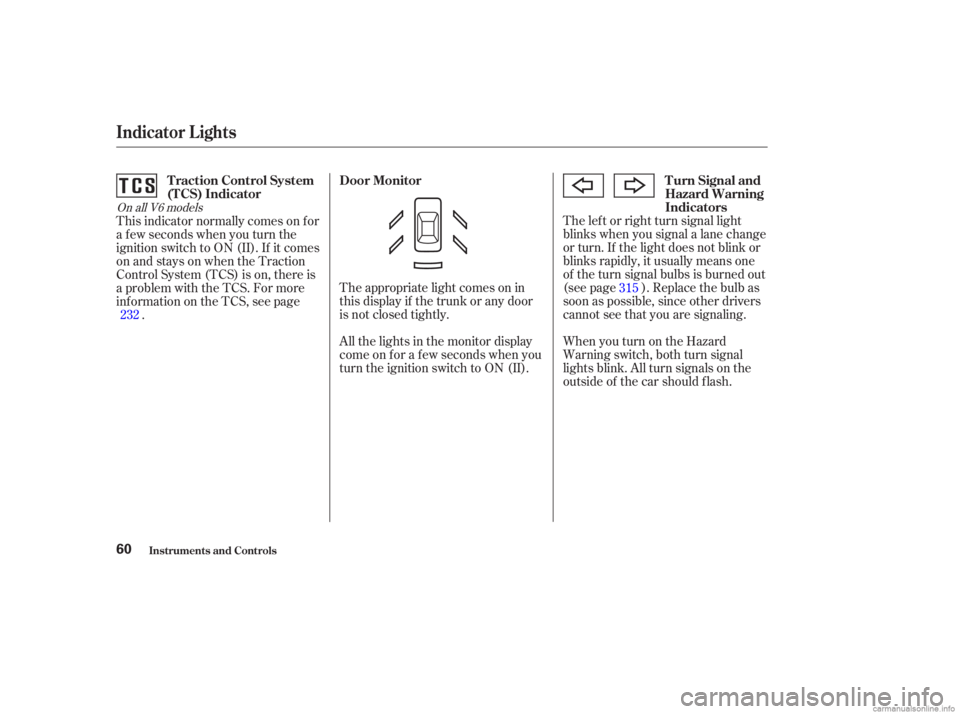
The appropriate light comes on in
this display if the trunk or any door
is not closed tightly.
All the lights in the monitor display
come on f or a f ew seconds when you
turn the ignition switch to ON (II).The lef t or right turn signal light
blinks when you signal a lane change
or turn. If the light does not blink or
blinks rapidly, it usually means one
of the turn signal bulbs is burned out
(see page ). Replace the bulb as
soon as possible, since other drivers
cannot see that you are signaling.
WhenyouturnontheHazard
Warning switch, both turn signal
lights blink. All turn signals on the
outside of the car should f lash.
This indicator normally comes on f or
a f ew seconds when you turn the
ignition switch to ON (II). If it comes
on and stays on when the Traction
Control System (TCS) is on, there is
a problem with the TCS. For more
inf ormation on the TCS, see page
.
232 315
On all V6 models
Indicator L ights
Inst rument s and Cont rols
Traction Control System
(T CS) Indicator
Door Monitor
T urn Signal and
Hazard Warning
Indicators
60
Page 77 of 395
Push the lever up to lock the
steering wheel in that position.The master key fits all the locks on
your car:
Ignition
Doors
Trunk
Glovebox
Trunk release handle
Trunk pass-through cover
Rear seat trunk access Your car comes with two master
keys and a valet key.
Move the steering wheel up or
down, and in or out to the desired
position, making sure the wheel
points toward your chest, not
toward your f ace. Make sure you
can see the instrument panel
gauges and the indicator lights. Make sure you have securely
locked the steering wheel in place
by trying to move it up, down, in,
and out.
3. 4.
5.
Controls Near the Steering Wheel, K eys and L ocks
Inst rument s and Cont rols
Keys
74
Page 78 of 395
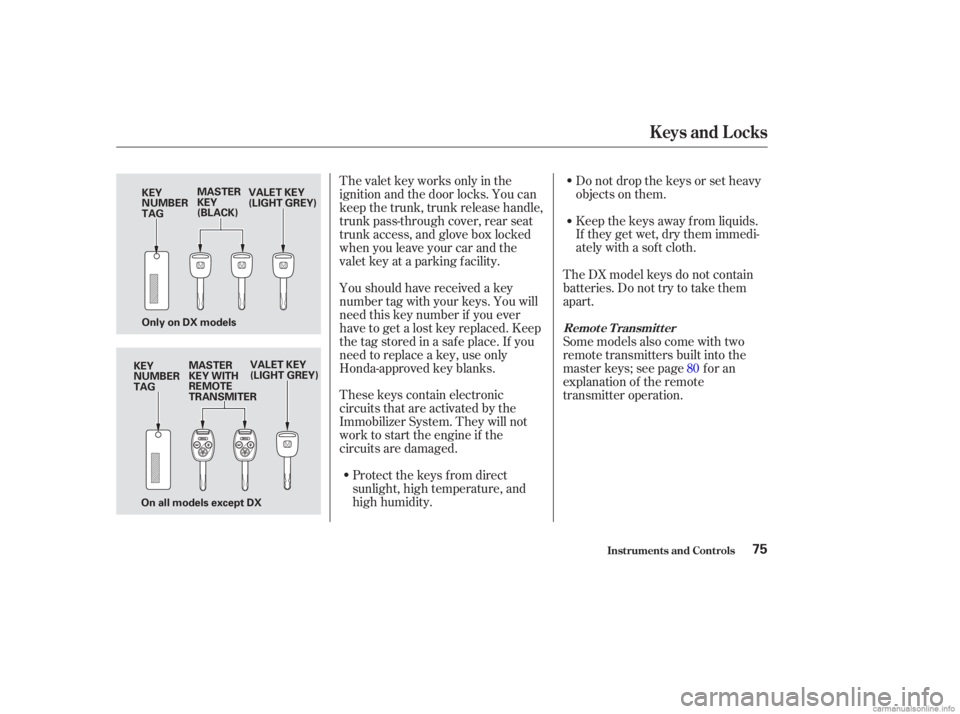
These keys contain electronic
circuits that are activated by the
Immobilizer System. They will not
work to start the engine if the
circuits are damaged.Protect the keys f rom direct
sunlight, high temperature, and
high humidity. Donotdropthekeysorsetheavy
objects on them.
Keep the keys away f rom liquids.
If they get wet, dry them immedi-
ately with a soft cloth.
The valet key works only in the
ignition and the door locks. You can
keep the trunk, trunk release handle,
trunk pass-through cover, rear seat
trunk access, and glove box locked
when you leave your car and the
valet key at a parking f acility.
The DX model keys do not contain
batteries. Do not try to take them
apart.
Youshouldhavereceivedakey
number tag with your keys. You will
need this key number if you ever
have to get a lost key replaced. Keep
the tag stored in a safe place. If you
need to replace a key, use only
Honda-approved key blanks. Some models also come with two
remote transmitters built into the
master keys; see page f or an
explanation of the remote
transmitter operation.80
Keys and Locks
Inst rument s and Cont rols
Remote Transmitter
75
MASTER
KEY
(BLACK)
MASTER
KEY WITH
REMOTE
TRANSMITER VALET KEY
(LIGHT GREY)
VALET KEY
(LIGHT GREY)
Only on DX models
On all models except DX KEY
NUMBER
TAG
KEY
NUMBER
TAG